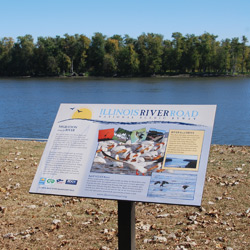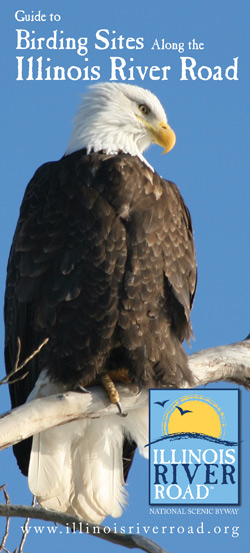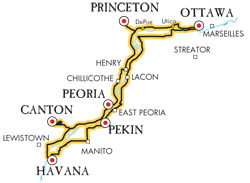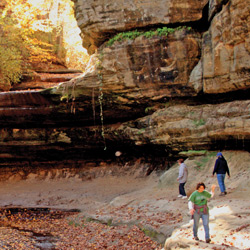
The Illinois River Road National Scenic Byway exemplifies the growing trend of experiential tourism.
Engaging Local Economies
Today, small and locally-owned businesses are declining in number and national chains are becoming the norm in our communities. The Illinois River Road National Scenic Byway, a program of the Economic Development Council for Central Illinois, is trying to change that reality. The people behind the Illinois River Road National Scenic Byway know the Illinois River Road is more than just directional signs along the roadway. The elite designation given by the U.S. Department of Transportation Federal Highway Administration opens doors and provides opportunities for those lesser-known, but authentic, “mom and pop” businesses to thrive in the communities along the route.
The National Scenic Byway Program is about much more than pointing travelers to the “scenic route.” America’s byways lead visitors to some of our nation’s most treasured places—places that are unique for their historical, archaeological, cultural, natural, recreational and scenic qualities. These 150 roadways, of which the Illinois River Road is one, represent the depth and breadth of America. Byway travelers get off the beaten path and experience the Illinois River Road’s intrinsic qualities by exploring the communities along the route. This “experiential tourism” involves learning about and sharing in local history and culture. Shopping in locally-owned stores, purchasing unique or authentic items, dining in local establishments (not chain restaurants), attending cultural events, festivals and local goings-on are all things byway travelers want to experience, and they impact our local economies as a result of their visit to the byway region.
Final touches are currently being put on an Illinois River Road byway-wide study being conducted by the EDC to identify opportunities for sustainable business growth in each of the communities along the Byway. Emphasis is being placed on authentic and locally-owned businesses which feature locally made or grown products and/or locally unique experiences. This study was funded, in part, by a National Scenic Byway Program grant from the Federal Highway Administration. Determining what other types of businesses are needed throughout the corridor to complement the visitor’s experience, based upon a gap analysis that includes input from communities, visitors and existing businesses, will assist us in marketing our communities to entrepreneurs who might otherwise set up shop in other unique regions or communities.
 “Providing visitors with more to do and more ways to spend their money will encourage them to stay longer, explore more and return again. Not only does all this activity make a direct economic impact, it adds to our own community vibrancy, making the region a more desirable place to live, work and shop,” states Brad McMillan, board chairman of the Illinois River Road National Scenic Byway.
“Providing visitors with more to do and more ways to spend their money will encourage them to stay longer, explore more and return again. Not only does all this activity make a direct economic impact, it adds to our own community vibrancy, making the region a more desirable place to live, work and shop,” states Brad McMillan, board chairman of the Illinois River Road National Scenic Byway.
Next steps for economic development along the Illinois River Road include engaging rural, authentic micro-enterprises by connecting them to resources, training and providing customized business technical assistance, while utilizing existing community resources wherever possible. The objective is for small businesses to gain knowledge about their local connections to the Byway and benefit by having a greater presence in Byway activities, marketing materials and advertising. These businesses will strengthen their communities by making them more “tourist-ready” and positioning them to respond to visitors’ unique needs.  Developing Our Tourism Product
Developing Our Tourism Product
In addition to having more than 100 designated nature sites and 16 gateway, portal and supporting communities—each with unique offerings—new programs are being created to draw visitors to our region, as well as entice those who live and work here to get out, explore and enjoy.
Interpretive panels designed to educate visitors about specific byway waypoints have been placed at sites throughout the region. Grandview Drive, Chillicothe’s Shore Acres Park and Pekin’s McNaughton Park are just a few of the byway sites that are home to panels that interpret the natural areas and help provide visitors with a greater appreciation for those spots.
The Illinois River Road joins the growing interest of geocaching with the launch of its own geocache program. Ninety caches are being placed throughout the byway region, adding to the 1.3 million active caches worldwide. This program has been designed to appeal not only to the five million cachers out there, but also those seeking a fun outdoor activity that connects people to our natural assets—with a reward at the end! Finding 10 of the 15 caches in each of the gateway communities enables treasure hunters to purchase a collectible coin unique to that community.
For those seeking firsthand glimpses of our region’s diverse wildlife, plant life and wetland restoration projects, visitors can now pick up or download two of the newest program guides: Guide to Birding Sites Along the Illinois River Road and Bringing Back Nature—Restoration & Conservation Efforts Along the Byway. Both guides provide additional ways to experience, learn about and enjoy the beauty of this region. iBi
 » What is Experiential Tourism?
» What is Experiential Tourism?
Experiential tourism encourages visitors to actively participate in the experience and promotes activities that draw people outdoors and into local nature, cultures and communities.
- It communicates “the story of the place” and it shows rather than describes.
- People create meaning through direct experience, and that experience includes the people met, the places visited, activities participated in, and the memories created.
- Experiential tourism is very personal, unique and individual for each visitor.
- Experiential tourism is low-impact, low-volume, and high-yield. It responds to the needs of local areas for sustainable economic development with minimal impact on the environment.
Source: Experiential Tourism around the World and at Home: Definitions and Standards by William L. Smith of Emporia State University; Ted Eubanks of Fermata, Inc.

